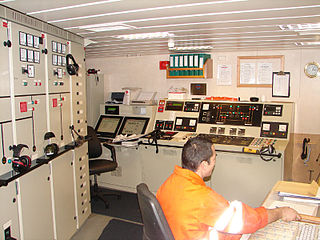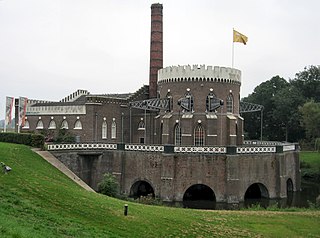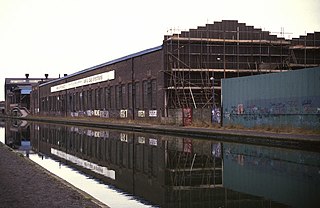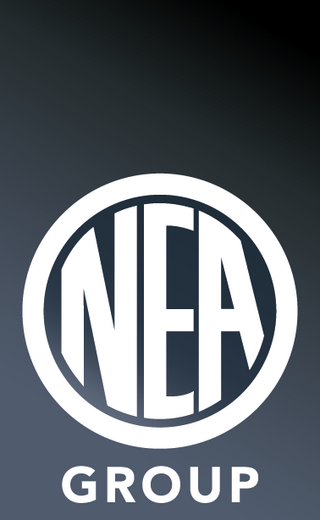
Richard Trevithick was a British inventor and mining engineer. The son of a mining captain, and born in the mining heartland of Cornwall, Trevithick was immersed in mining and engineering from an early age. He was an early pioneer of steam-powered road and rail transport, and his most significant contributions were the development of the first high-pressure steam engine and the first working railway steam locomotive. The world's first locomotive-hauled railway journey took place on 21 February 1804, when Trevithick's unnamed steam locomotive hauled a train along the tramway of the Penydarren Ironworks, in Merthyr Tydfil, Wales.

A compressor is a mechanical device that increases the pressure of a gas by reducing its volume. An air compressor is a specific type of gas compressor.

A scroll compressor is a device for compressing air or refrigerant. It is used in air conditioning equipment, as an automobile supercharger and as a vacuum pump. Many residential central heat pump and air conditioning systems and a few automotive air conditioning systems employ a scroll compressor instead of the more traditional rotary, reciprocating, and wobble-plate compressors.
Economizers, or economisers (UK), are mechanical devices intended to reduce energy consumption, or to perform useful function such as preheating a fluid. The term economizer is used for other purposes as well. Boiler, power plant, heating, refrigeration, ventilating, and air conditioning (HVAC) uses are discussed in this article. In simple terms, an economizer is a heat exchanger.

An engineering officer or simply engineer, is a licensed mariner qualified and responsible for operating and maintaining the propulsion plants and support systems for a watercraft and its crew, passengers and cargo. Engineering officers are usually educated and qualified as engineering technicians.

A Cornish engine is a type of steam engine developed in Cornwall, England, mainly for pumping water from a mine. It is a form of beam engine that uses steam at a higher pressure than the earlier engines designed by James Watt. The engines were also used for powering man engines to assist the underground miners' journeys to and from their working levels, for winching materials into and out of the mine, and for powering on-site ore stamping machinery.

Elliott Company designs, manufactures, installs, and services turbo-machinery for prime movers and rotating machinery. Headquartered in Jeannette, Pennsylvania, Elliott Company is a wholly owned subsidiary of the Japan-based Ebara Corporation, and is a unit of Elliott Group, Ebara Corporation's worldwide turbomachinery business. Elliott Group employs more than 2000 employees worldwide at 32 locations, with approximately 900 in Jeannette.

Bryan Donkin FRS FRAS developed the first paper making machine and created the world's first commercial canning factory. These were the basis for large industries that continue to flourish today. Bryan Donkin was involved with Thomas Telford's Caledonian Canal, Marc and Isambard Brunel's Thames Tunnel, and Charles Babbage's computer. He was an advisor to the government and held in high esteem by his peers.
Alexander Petrie and Co was a company that manufactured stationary steam engines. It was based in Rochdale, Greater Manchester in England. The company did general millwrighting, producing some steam engines during the 19th century. Around 1845, their superintendent, William McNaught, was producing large steam-driven beam engines for textile mills in Rochdale.

Daikin Industries, Ltd. is a Japanese multinational conglomerate company headquartered in Osaka. Daikin is the world's largest air conditioner manufacturer.

A semi-portable engine is a form of stationary steam engine. They were built in a factory as a single unit including the boiler, so that they could be rapidly installed on site and brought into service.

Belliss and Morcom is a manufacturer and supplier of oil-free reciprocating compressors, technologies and services. Founded in 1852 in Birmingham, West Midlands, it is now a division of Ingersoll Rand based in Redditch, Worcestershire, England.

The Nottingham Industrial Museum is a volunteer-run museum situated in part of the 17th-century stables block of Wollaton Hall, located in a suburb of the city of Nottingham. The museum won the Nottinghamshire Heritage Site of the Year Award 2012, a local accolade issued by Experience Nottinghamshire. The Museum collection closed in 2009 after Nottingham City Council withdrew funding, but has since reopened at weekends and bank holidays, helped by a £91,000 government grant, and run by volunteers. The museum contains a display of local textiles machinery, transport, telecommunications, mining and engineering technology. There is a display of cycles, motorcycles, and motor cars. There are examples of significant lace-making machinery. It also houses an operational beam engine, from the Basford, Nottingham pumping station.

NEUMAN & ESSER GROUP (NEA) was founded as a family establishment in Aachen, Germany in 1830. The abbreviation, NEA, stands for "NEUMAN & ESSER in Aachen". NEA is a manufacturer of reciprocating compressors and grinding systems for several industries, including oil and gas, chemical and petrochemical, food industry and renewable energy.
Nordberg Manufacturing Company was a manufacturer of steam engines, large diesel engines, pumps, hoists and compressors for the mining and quarry industries located in Milwaukee, Wisconsin.

The machine industry or machinery industry is a subsector of the industry, that produces and maintains machines for consumers, the industry, and most other companies in the economy.

The Grimsby Ice Factory is a former factory located in Grimsby, England, that was constructed from 1898–1901 to provide crushed ice to preserve fish stored in ships at Grimsby's seaport. The Grimsby Ice Factory engaged in operations up to 1990. The buildings still contain some of the original historic machinery from times of the operations' origins. During its time of prime operations, it produced 1,200 tonnes of ice daily. The building is 4,350 square metres in size, and at one time it was the largest ice factory in the world. The building is deteriorating, and it has been stated that it will eventually crumble if restoration efforts are not undertaken. Furthermore, historic machinery at the site is at risk from exposure to the elements, because the roof is not watertight.

Láng Machine Factory was a machine factory in Hungary that played an important role in supplying Hungarian power plants and factories with steam engines, turbines and diesel motors.
John Hall was an English millwright and mechanical engineer, who, in 1785, founded the Dartford-based engineering company which became J & E Hall, today a prominent supplier of refrigeration machinery, and part of the Daikin group. During Hall's lifetime, he helped mechanise the papermaking industry, co-founded the first UK canning firm, and developed steam engines for land and marine use.
Thermotank was a Scottish engineering company specialising in heating, ventilation and air conditioning, founded in Glasgow in 1900 by Alexander William Stewart and his two brothers William and Frederick. The business was based on Alexander’s invention, the Thermotank, a system designed for maritime use which could maintain a constant temperature coupled to a change of air on board ships.















